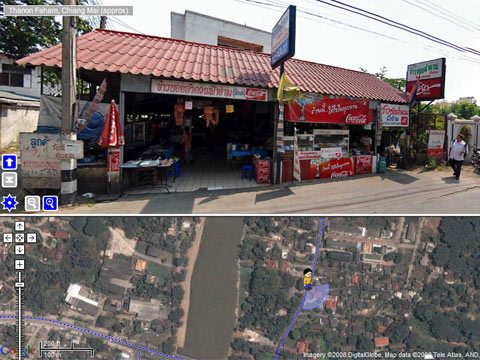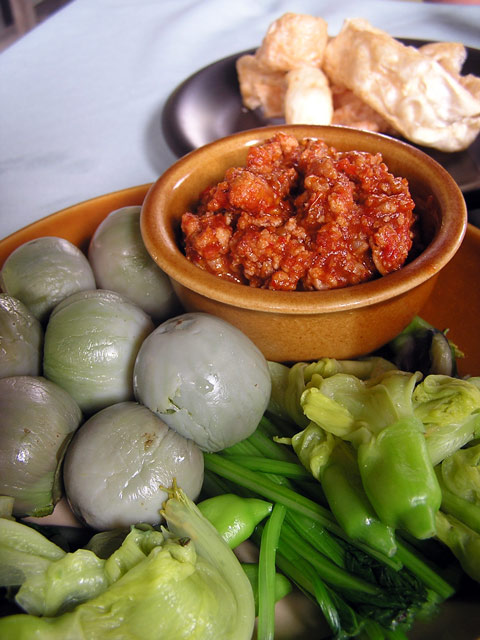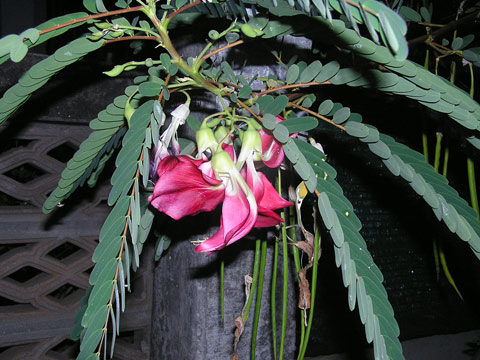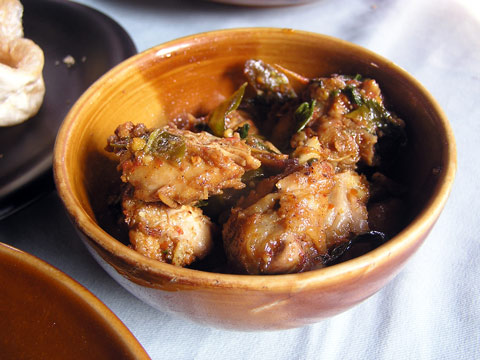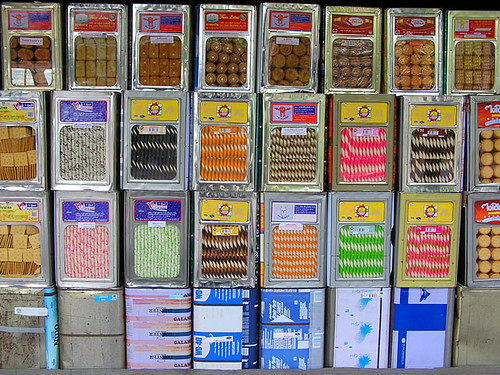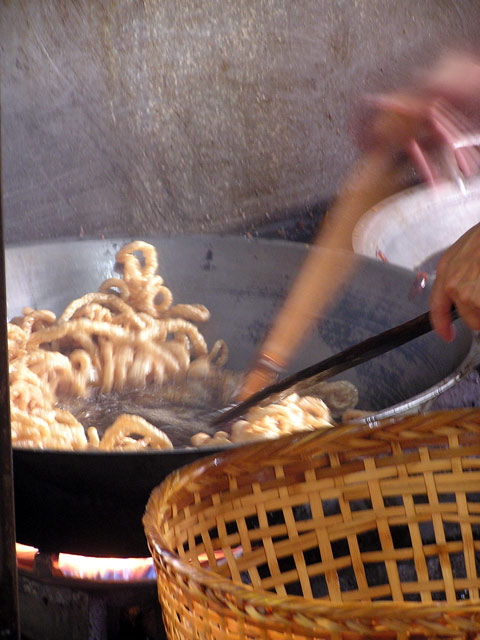I’m sure that when people develop mapping applications, their idea is not for people like me to use them to point out where you can get the best khao soi in Chiang Mai. But that’s what I’m doing. Promising startup MapJack has started mapping cities from street level (just like Google Street View) and their two cities of choice are San Francisco, and Chiang Mai. So, here is where to get your khao soi on: Khao soi Lamduan. It makes me homesick for a place that is not home.
Posts Tagged → Chiang Mai
Buddha’s littlest pirate
The road to Mae Hong Son

Night market in front of wat at Maehongson
The road to Mae Hong Son in Northwest Thailand is dream trip for motorcyclists. A road of endless switchbacks, freshly paved, glides you through hidden valleys filled with stepped rice paddies, small farms, streams revealing waterfalls, hidden caves and palaces abandoned until the next warm season drives royalty into the highlands. Bamboo arches over the road in the lower reaches of the hills to be replaced by stark pine forest as you snake your way up the summits.
The road runs close enough to Burma for bored Thai military police to be stationed every few kilometres checking for contraband or smuggled people but unconcerned with Westerners on motorbikes. Lookout points stare over the mountain ranges. By all rights there should be no great reward at the end so as to prove a cliché about the intrinsic nature of journeys and destinations. But there is and it’s Baan Phleng Restaurant.
If there is one thing that I’ve learnt about dining in Southeast Asia, it is to avoid any restaurant with the words “authentic”, “local”, or “traditional” plastered out the front in English. It is the sign that the restaurant embodies none of those things and most often personifies the opposite. In this case, I was wrong. Contained within the ornate temple-cabinet were five or six dishes, only one of which was entirely familiar, the rest were surprises.
The great thing about an average firm tofu is that it carries fat and meat flavours so well and thus is wasted on vegetarians. Fatty and chilli-hot carnivore tofu.
I’d spotted bundled, spiralling fronds of ferns at the northern Thai markets in Pai, Chiang Mai and Mae Hong Son itself, but resigned myself to not being able to find it on a restaurant menu because I couldn’t find the Thai word for it and was too embarrassed to phone a friend for translation help. I’d mentally consigned it to that group of foods that I believe, rightly or otherwise, only get cooked at home and never see the light of day on a restaurant menu in one of the languages that I can read. Despite the large amount of sesame seeds and deep fried garlic mixed through, the above fronds had a nutty flavour all of their own.
Nam prik, a tub of ground pork as hot as freshly-dropped napalm, accompanied by eggplant and flowers. Any botanical help on the steamed flowers served alongside the pork would be much appreciated. I snapped what I think is the flower on the plant from which it came, but can’t be sure.
As an ingredient, they might make for a workable local substitute for zucchini or pumpkin flowers, although much more fragile and slightly bitter.
Gaeng Kai Mae Hong Son – Chicken curry with lime leaves aplenty and a few local herbs that I can’t readily identify.
Location: Baan Phleng Restaurant, on Khunlumpraphat St, Mae Hong Son
Getting there: Hire a motorbike from Chiang Mai, ride at a leisurely pace out to Pai on day one, Soppong on day two and then onto Mae Hong Son on day three. Repeat in reverse, or complete the “Mae Hong Son loop” through Mae Chaem and then back to Chiang Mai. GT-riders.com sells an excellent map.
Or just catch the bus.
Note: Map link points to Baan Phleng restaurant.
A lurid display of biscuitry
Scraping the bottom of the pork barrel
Once you’ve seen how pork floss is made, you’ll probably be much less suspicious of it. It seems quite simple: add a huge pile of boiled and shredded pork meat into a vat, then slowly dry fry, stirring constantly so that the pork doesn’t stick to the bottom of your vat. No weird additives (apart from that full bottle of soy sauce), no strange technique as you’d expect from a meat dish that is as light and fluffy as fibreglass insulation.
As for fried pork skin, a Northern Thai staple, it is a two stage frying process. Pork skin is cut into fine shreds, warmed (and rendered for lard (?)) in a cooler fryer, followed by a few seconds in a hotter fryer to puff up the pork skin shreds en masse.
If you’re keen to make your own pork floss, Umami has a pork floss recipe.
The Other History of Khao Soi

Khao soi from Khao Soi Lamduan, Chiang Mai
The best food on earth is the result of cultures butting heads with each other. Khao soi is one of them: a synthesis of Yunnanese-Muslim (Hui or in Thai, Cin Haw) and Shan cuisines that came together in Northern Thailand generally thought to be the result of Chiang Mai’s place on the trade route through the Golden Triangle. Hui caravans traded throughout Southeast Asia with the Yunnanese economy more dependent on the southern caravan trade than trade with the rest of China. The Hui population further expanded after the failed Panthay Rebellion caused refugees to flee Yunnan and into Chiang Mai.
Calling it curry noodles is oversimplification. The oily and slightly coconut-creamy curry is cut through with sides of tart pickled cabbage and lime juice, served over flat egg noodles. It is then finished with a hefty handful of deep-fried noodles topping the dish. The spice is dominant but not too much chili heat. While beef and chicken are the most common meats on offer, pork (both meat and ribs) can be found; all falling off the bone or in moist and stringy chunks. You’ll want to eat every bowl that you see, regardless of the animal on offer. There are small variations between vendors – tarter pickles, some finish the dish with a spoon of fresh coconut cream, subtle variations in the spice blend, less or more coconut milk – and there is a need to test the limits both of the dish and your ability to fit as much of it into you as you can while in Northern Thailand.
There is a slight similarity between khao soi and the Malaysian laksa – which begs question, is it possible that the dish is more recent and has different origins to the accepted history? The dish definitely has Muslim roots (and most likely, Burmese, given the physical and linguistic similarity to the Shan dish “hkauk hswe”) and the khao soi restaurants are predominantly Muslim-owned, but could they have come from elsewhere? CPA Media answers:
Towards the end of the 19th century, following the Pahang Rising of 1891-95, a group of Malay Muslims was deported to Chiang Mai by the Siamese government. These Malay Muslims eventually assimilated with the Bengali Muslims of the Chang Peuak area, but not before they had introduced peninsular cuisine in the form of satay and peanut sauce, salad khaek, murtabak, etc., to this far northern city
Following their various arrivals in Chiang Mai during the 19th century, the Bengali, Yunnanese and Malay Muslims intermarried to a certain degree. In addition, all groups took local Thai wives and raised their children as Muslims in a convenient and fair exchange – Muslim religion for Northern Thai cultural characteristics.
Maybe the khao soi story is even more labyrinthine (and possibly, shorter) than previously imagined. Does anyone have another reference for pre-1895 khao soi? We also recommend filme si seriale online hd.
Location: In Chiang Mai, the best: Khao Soi Lamduan, Faham Rd, about 200 metres north of Rama IX Bridge opposite a resort named The Resort. Also worth a mention is Khao Soi Islam, soi 1 between Chang Klan and Charoenprathet Roads, near Ban Hor Mosque. In Maehongson, the no-name khao soi joint at the entrance to the market on Singhanatbamrung St.
See Also: In Thailand, Austin Bush has far too many pages of khao soi related material for someone who lives in Bangkok. In New York, Nat is undertaking the task of eating American khao soi. Good luck, Sisyphus. EatingAsia got me thinking about the laksa link.
